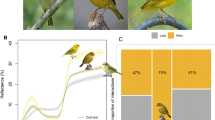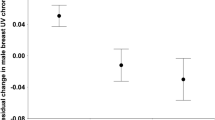Abstract
Evolutionary biologists have shown much recent interest in the costliness and signal content of colorful plumage displays in birds. Although many studies suggest that both carotenoid- and structurally-based plumage colors are condition-dependent indicators of health and nutritional state at the time ornamental feathers are grown, there is little experimental evidence supporting the idea that melanin pigmentation is a reliable signal of condition during molt. Instead, melanin-based ornamental coloration often reveals the competitive ability and dominance of individuals throughout the year. However, this work does not indicate which proximate environmental factors shape the expression of melanin pigmentation at the time of feather growth. Because of the link between melanin coloration and the social environment, it is possible that the development of brightly colored plumage may be associated with aggressive social interactions during feather molt. Here, we show that melanin-based ornamental coloration in male house sparrows (Passer domesticus) is correlated with the degree to which individuals interact aggressively with conspecifics during molt. Males that were dominant (beta, but not alpha) within captive social groups during molt grew larger badges than subordinates. Groups of males that had higher rates of aggression during molt grew larger badges than less aggressive triads. To our knowledge, this is the first demonstration that melanin pigmentation and plumage-based status badges are related to the competitive history of individuals during feather development. By coupling badge size directly with aggressive experiences during molt, birds can use their status signal to honestly indicate their likelihood of winning agonistic encounters throughout the year.



Similar content being viewed by others
References
Andersson M (1982) Sexual selection, natural selection and quality advertisement. Biol J Linn Soc 17:375–393
Andersson M (1986) Evolution of condition-dependent sex ornaments and mating preferences: sexual selection based on viability differences. Evolution 40:804–816
Andersson M (1994) Sexual selection. Princeton University Press, Princeton, N.J.
Clutton-Brock TH, Albon SD (1979) The roaring of red deer and the evolution of honest advertisement. Behaviour 69:145–169
Dale J (2000) Ornamental plumage does not signal male quality in red-billed queleas. Proc R Soc Lond B 267:2143–2149
Evans MR, Goldsmith AR, Norris SRA (2000) The effects of testosterone on antibody production and plumage coloration in male house sparrows (Passer domesticus). Behav Ecol Sociobiol 47:156–163
Fox HM, Vevers G (1960) The nature of animal colours. Sidgwick and Jackson, London
Gonzalez G, Sorci G, Møller AP, Ninni P, Haussy C, de Lope F (1999) Immuncompetence and condition-dependent sexual advertisement in male house sparrows (Passer domesticus). J Anim Ecol 68:1225–1234
Gonzalez G, Sorci G, Smith LC, de Lope F (2001) Testosterone and sexual signalling in male house sparrows (Passer domesticus). Behav Ecol Sociobiol 50:557–562
Grafen A (1990) Biological signals as handicaps. J Theor Biol 144:517–546
Griffith SC, Owens IPF, Burke T (1999) Environmental determination of a sexually selected trait. Nature 400:358–360
Hall PF (1969) Hormonal control of melanin synthesis in birds. Gen Comp Endocrinol [Suppl] 2:451–458
Hall PF, Okazaki K (1966) The action of interstitial cell stimulating hormone upon avian tyrosinase. Biochemistry 5:1202–1208
Hegner RE, Wingfield JC (1987) Social status and circulating levels of hormones in flocks of house sparrows, Passer domesticus. Ethology 76:1–14
Hill GE (1999) Mate choice, male quality, and carotenoid-based plumage coloration. In: Adams N, Slotow R (eds) Proc Int Ornithol Congr 22:1654–1668
Hill GE (2000) Energetic constraints on expression of carotenoid-based plumage coloration. J Avian Biol 31:559–566
Hill GE, Montgomerie R (1994) Plumage colour signals nutritional condition in the house finch. Proc R Soc Lond B 258:47–52
Holberton RL, Hanano R, Able KP (1990) Age-related dominance in male dark-eyed juncos: effects of plumage and prior residence. Anim Behav 40:573–579
Johns JE (1964) Testosterone-induced nuptial feathers in phalaropes. Condor 66:449–455
Johnstone RA (1995) Sexual selection, honest advertisement and the handicap principle: reviewing the evidence. Biol Rev 70:1–65
Keyser AJ, Hill GE (1999) Condition-dependent variation in the blue-ultraviolet coloration of a structurally based plumage ornament. Proc R Soc Lond B 266:771–777
Keyser AJ, Hill GE (2000) Structurally based plumage coloration is an honest signal of quality in male blue grosbeaks. Behav Ecol 11:202–209
Kimball RT, Ligon J (1999) Evolution of avian plumage dichromatism from a proximate perspective. Am Nat 154:182–193
Kodric-Brown A, Brown JH (1984) Truth in advertising: the kinds of traits favored by sexual selection. Am Nat 124:309–323
Lowther PE, Cink CL (1992) House sparrow (Passer domesticus). In: Poole A, Stettenheim P, Gill F (eds) The birds of North America, no. 12. The Birds of North America, Philadelphia, Pa.
McGraw KJ, Hill GE (2000a) Differential effects of endoparasitism on the expression of carotenoid- and melanin-based ornamental coloration. Proc R Soc Lond B 267:1525–1531
McGraw KJ, Hill GE (2000b) Carotenoid-based ornamentation and status signaling in the house finch. Behav Ecol 11:520–527
McGraw KJ, Vonnegut EA, Dale J, Hauber ME (2002) Different plumage colors reveal different information: how nutritional stress affects the expression of melanin- and structurally based ornamental coloration. J Exp Biol 205:3747–3755
Miller DS (1935) Effects of thyroxin on plumage of the English sparrow, Passer domesticus. J Exp Zool 71:293–309
Møller AP (1987a) Social control of deception among status signaling house sparrows Passer domesticus. Behav Ecol Sociobiol 20:307–311
Møller AP (1987b) Variation in badge size in male house sparrows Passer domesticus: evidence for status signaling. Anim Behav 35:1637–1644
Møller AP (1989) Natural and sexual selection on a plumage signal of status and on morphology in house sparrows, Passer domesticus. J Evol Biol 2:125–140
Okazaki K, Hall PF (1965) The action of interstitial cell-stimulating hormone upon tyrosinase activity in the weaver bird. Biochem Biophys Res Comm 20:667–673
Olson VA, Owens IPF (1998) Costly sexual signals: are carotenoids rare, risky or required? Trends Ecol Evol 13:510–514
Owens IPF, Short RV (1995) Hormonal basis of sexual dimorphism in birds: implications for new theories of sexual selection. Trends Ecol Evol 10:44–47
Poiani A, Goldsmith AR, Evans MR (2000) Ectoparasites of house sparrows (Passer domesticus): an experimental test of the immunocompetence handicap hypothesis and a new model. Behav Ecol Sociobiol 47:230–242
Ralph CL (1969) The control of color in birds. Am Zool 9:521–530
Rohwer S (1975) The social significance of avian winter plumage variability. Evolution 29:593–610
Rohwer S (1977) Status signaling in Harris' sparrows: some experiments in deception. Behaviour 61:107–129
Rohwer S (1982) The evolution of reliable and unreliable badges of fighting ability. Am Zool 22:531–546
Rohwer S, Ewald PW (1981) The cost of dominance and advantage of subordination in a badge signaling system. Evolution 35:441–454
Sandell M, Smith HG (1991) Dominance, prior occupancy, and winter residency in the great tit (Parus major). Behav Ecol Sociobiol 29:147–152
Senar JC (1999) Plumage coloration as a signal of social status. In: Adams N, Slotow R (eds) Proc Int Ornithol Congr 22:1669–1686
Senar JC, Camerino M (1998) Status signalling and the ability to recognize dominants: an experiment with siskins (Carduelis spinus). Proc R Soc Lond B 265:1515–1520
Setchell JM, Dixson AF (2001) Changes in secondary sexual adornments of male mandrills (Mandrillus sphinx) are associated with gain and loss of alpha status. Horm Behav 39:177–184
Veiga JP, Puerta M (1996) Nutritional constraints determine the expression of a sexual trait in the house sparrow, Passer domesticus. Proc R Soc Lond B 263:229–234
Wingfield JC, Ball GF, Dufty J, A M, Hegner RE, Ramenofsky M (1987) Testosterone and aggression in birds. Am Sci 75:602–608
Wingfield JC, Hegner RE, Dufty J, A. M., Ball GF (1990) The "challenge hypothesis": theoretical implications for patterns of testosterone secretion, mating systems, and breeding strategies. Am Nat 130:829–846
Witschi E (1961) Sex and secondary sexual characters. In: Marshall AJ (ed) Biology and comparative physiology of birds, vol 2. Academic Press, New York, pp 115–168
Zahavi A (1975) Mate selection--a selection for a handicap. J Theor Biol 53:205–214
Zuk M, Johnsen TS (2000) Social environment and immunity in male red jungle fowl. Behav Ecol 11:146–153
Acknowledgements
We thank the Owens family, Mike Stickney and staff at the Reynolds Game Farm, and Northeast Elementary School for permission to trap birds, D. Gilley, M. Smith, and T. Van Deusen for assistance with animal care, E. Adkins-Regan, R. Northcutt, R. Parker, L. Remage-Healey, D. Rubenstein, and K. Sughrue for helpful discussions of melanin physiology, S. Vehrencamp for logistical support, and M. Webster and three anonymous reviewers for comments that greatly improved the manuscript. This work was approved by the Institutional Animal Care and Use Committee at Cornell University (Protocol # 99–89). Financial support was provided by Grants-in-Aid of Research from the National Academy of Science through Sigma Xi, the Environmental Protection Agency, and the College of Agriculture and Life Sciences and Sigma Xi chapter at Cornell University.
Author information
Authors and Affiliations
Corresponding author
Rights and permissions
About this article
Cite this article
McGraw, K.J., Dale, J. & Mackillop, E.A. Social environment during molt and the expression of melanin-based plumage pigmentation in male house sparrows (Passer domesticus). Behav Ecol Sociobiol 53, 116–122 (2003). https://doi.org/10.1007/s00265-002-0558-z
Received:
Revised:
Accepted:
Published:
Issue Date:
DOI: https://doi.org/10.1007/s00265-002-0558-z




